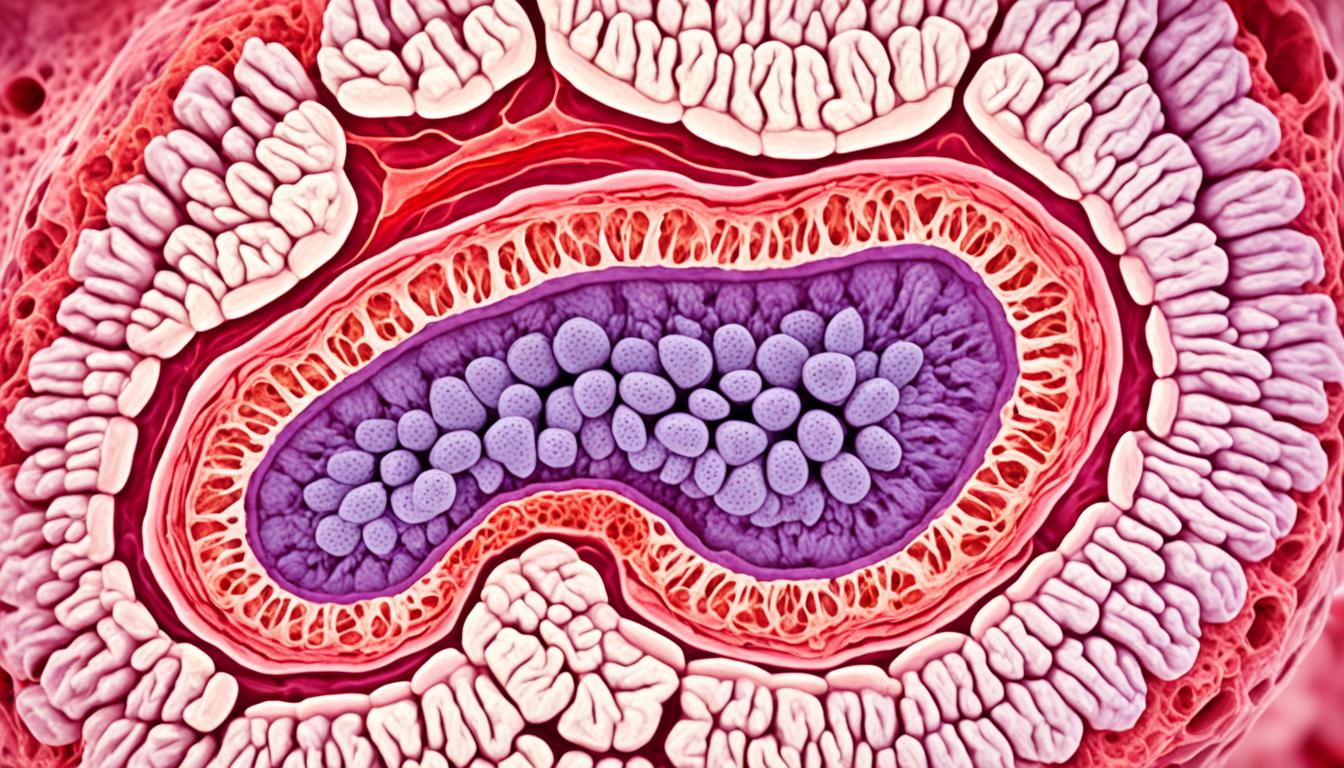Stomach polyps are abnormal growths inside the stomach wall. Most of the time, they’re harmless. But some can lead to cancer.
They can happen at any age but are more common in the elderly, over 65. Things like chronic gastritis and some infections can lead to them.
You might not notice any symptoms. But they can cause pain, nausea, and anemia. Doctors check for them with a test called gastroscopy.
How to treat polyps depends on their size and type. You might need them removed with a scope or surgery. It’s also important to keep an eye on them to look for cancer.
Key Takeaways:
- Stomach polyps are abnormal growths on the inner lining of the stomach wall.
- Gastric polyps are more commonly seen in the elderly, especially those over 65 years old.
- Factors contributing to stomach polyps include chronic gastritis, Helicobacter pylori infection, pernicious anemia, persistent damage to the gastric mucosa, and prolonged use of proton pump inhibitors.
- Symptoms of stomach polyps can be nonspecific, including abdominal pain, nausea, vomiting, chronic anemia, and symptoms of gastric obstruction.
- Diagnosis is typically made through a gastroscopy, where a flexible tube with a camera is inserted into the mouth to view the stomach lining.
- Treatment options for stomach polyps include endoscopic removal or surgery, depending on the size and type of the polyps.
- Regular monitoring is crucial to detect any changes or signs of malignancy in the polyps.
Types of Stomach Polyps and Their Characteristics
Stomach polyps are split into various types based on their histology and where they come from. The top three kinds are hyperplastic, adenomatous, and fundic gland polyps.
Hyperplastic polyps are usually small and come from ongoing inflammation or infection. They are mostly safe but should be checked regularly.
Adenomatous polyps might turn into cancer and need closer watching. They pose the biggest malignancy danger.
Fundic gland polyps appear after using proton pump inhibitors for a long time. They are often harmless and usually don’t need treatment.
Every kind of stomach polyp shows unique traits under a microscope. This helps choose the best way to manage and watch them.
| Type of Stomach Polyp | Characteristics |
|---|---|
| Hyperplastic Polyps | Typically small, benign growths |
| Adenomatous Polyps | Potential to become cancerous; requires further evaluation and monitoring |
| Fundic Gland Polyps | Result of long-term use of proton pump inhibitors; generally harmless |
Diagnosis and Monitoring of Stomach Polyps
Stomach polyps are often found during a procedure known as gastroscopy. This involves a flexible tube with a camera being inserted through the mouth. This way, doctors can see the lining of the stomach. They look at the size, place, and type of the polyps closely. Biopsies are taken to study the tissues and figure out what type of polyps they are.
It’s key to keep an eye on people with stomach polyps, especially if they’re big or adenomatous. This kind of monitoring helps spot any unusual changes early. During this process, more gastroscopies and biopsies may be done. These help see how the polyps are changing and catch any signs of cancer fast.
Endoscopy is very important in finding stomach polyps. It looks closely at the polyps and takes tissue samples for tests. The test results guide the treatment plan. Regular checks with gastroscopies and biopsies help track polyps and watch out for any harmful changes.
For those diagnosed with stomach polyps, sticking to the check-up schedule is vital. Following the doctor’s advice is crucial. Detecting problems early and getting the right care can make a big difference. It lowers the chances of polyps turning into cancer.
Treatment Options for Stomach Polyps and Conclusion
How stomach polyps are treated depends on their size, where they are, and what they are made of. Small polyps that are not adenomatous need checking now and then. But for adenomatous or bigger ones, they might need to be removed.
One way to treat stomach polyps is by endoscopic removal or polypectomy. This means taking them out while looking at them through a tube. It’s often done for smaller polyps that are easy to reach.
If there are a lot of polyps, they’re big, or hard to reach with a scope, surgery might be the best choice. Surgery can completely remove the polyps. This is important for making sure they don’t come back.
Managing and keeping an eye on stomach polyps is key. This helps catch and treat any cancers early. Keeping up with check-ups and living healthy can lower the chances of getting stomach polyps. It also helps with better health in the long run.

